Approximately 25km west of the Latvian capital, Riga, Jūrmala is a sprawling resort town that stretches along the Baltic Sea for about 30km. The beach is wide, sandy and backed by grassy dunes and a dense pine forest. It’s a lovely spot, especially outside of the summer months and the weekends when it is easy to find a section of beach you can claim as your own.
Jūrmala established itself as a beach resort in the latter part of the 18th century/turn of the 19th century. Originally, wealthy civilians holidayed here and then, at the end of the Napoleonic Wars (circa 1815), Russian military personnel came to recuperate, breath in the healthy seaside air, and ‘take the waters’. Soon Jūrmala’s reputation as a spa town grew.
You can still see architecture dating back from that period, both on the beachfront and in the town itself. There are lots of wooden houses and public structures in various degrees of restoration, as well as buildings in the style of Art Nouveau, dotted throughout the area. It’s pleasing on the eye but it wasn’t our primary reasoning for visiting Jūrmala when we were in Latvia in May 2018.
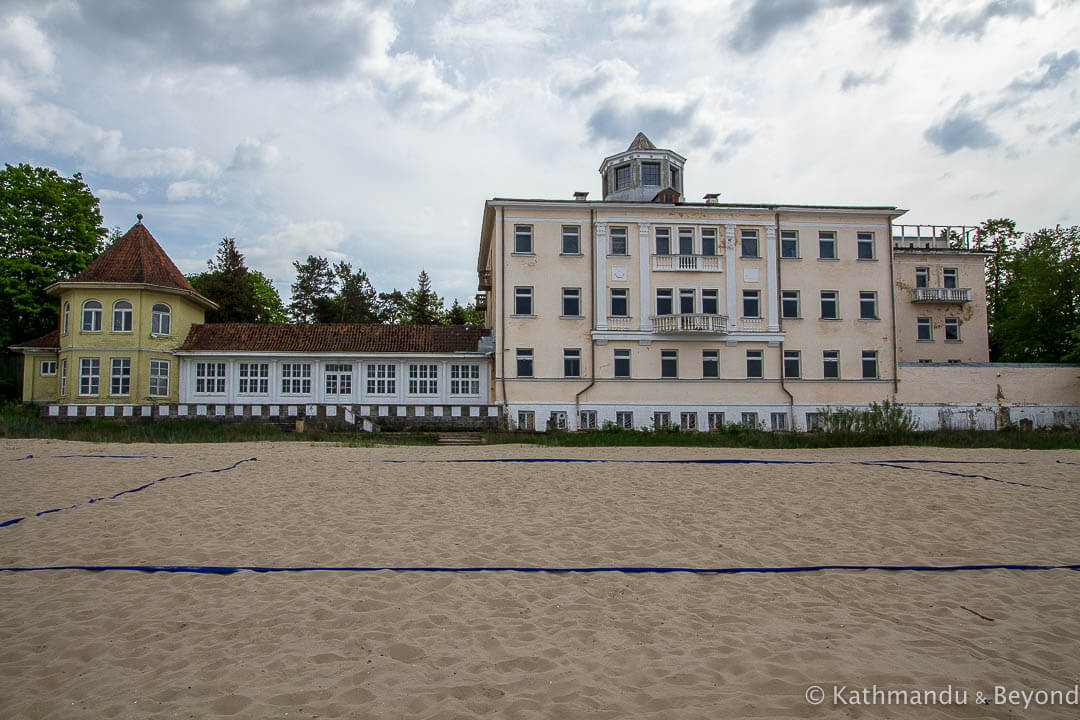 A pre-Soviet sanatorium on the beachfront at Jūrmala. It is no longer in use but, no doubt, awaiting renovation
A pre-Soviet sanatorium on the beachfront at Jūrmala. It is no longer in use but, no doubt, awaiting renovation
The history of sanatoriums in Jūrmala
During Soviet times (1940-1991), when Latvia was officially called the Latvian Soviet Socialist Republic (or Latvian SSR for short), Jūrmala became one of the most desirable places to holiday in the whole of the USSR. It became popular with the communist party elite and top-ranking officials, including Nikita Khrushchev and Leonid Brezhnev, and the promise of a vacation in Jūrmala was frequently used to incentivise party members to perform well in their field of work.
With the influx of visitors came the need for more accommodation and this was provided in the form of enormous sanatoriums that were either brutalist or modernist in design.
Sanatoriums in the USSR date back to the early 1920s and were established, on order of Lenin himself, as a place where Soviet workers could be sent for a couple of weeks of each year in order to recharge their batteries both mentally and physically before returning to the toils of their daily job. The schedule for guests staying in these sanatoriums was pretty rigid, however. These weren’t resorts designed for enjoying yourself in the traditional sense of being on holiday, but rather a kind of medical hotel/spa where any ailments you might have could hopefully be cured. Plenty of exercise and a good night’s sleep were also part of the programme. Sanatoriums were originally funded by the state and at their height, received millions of citizens from all over the Soviet Union on an annual basis.
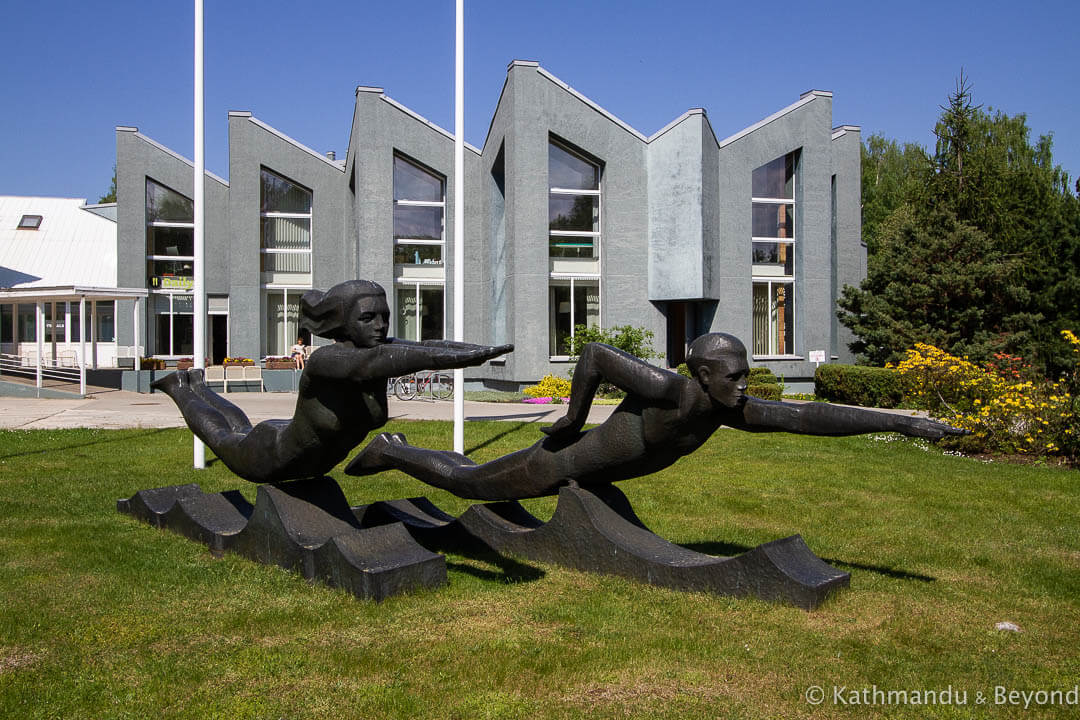 Vaivari Sanatorium
Vaivari Sanatorium
Soviet sanitariums in Jūrmala today
There aren’t many of these vestiges of the Soviet-era left in Jūrmala. In fact, since the lowering of the hammer and sickle in late 1991, they have become a dying breed throughout the former union. That said, we still managed to identify five sanatoriums in Jūrmala that sparked our interest architecturally plus, we pinpointed a restaurant called Jūras Pērle (which would have been built around the same time) that was also worthy of a closer look. Using a combination of foot power and driving (see the Visiting the Sanatoriums section below), we managed to see all of the sanatoriums on our list but, unfortunately, we discovered that the fantastic-looking restaurant (click here to see what it looked like) had been demolished a few years back.
As each of the five sanatoriums we visited were still functional (and have their own websites), it was easy to find additional information about them but, unfortunately for me, this was more along the lines of current package rates, facilities, treatments offered and that sort of thing and I had a hard job discovering historical facts about the buildings themselves (*).
(*) Some of the fully-inclusive packages, which include board and lodging as well as a program of treatments, are very good value, especially if you visit outside of the summer season. As part of our fascination with Soviet sanatoriums, perhaps we should consider taking it to the next level and checking into one of them for a few days or more – it would make for an interesting follow-up blog!
Belarusian Sanatorium
As its name would suggest, the Belarusian Sanatorium was originally constructed for the exclusive use of citizens from the Byelorussian SSR (now Belarus). After the Chernobyl disaster in late April 1986, large areas of Belarus were contaminated, and children from affected regions were sent to the sanatorium in a bid to improve their health (*). Whether or not the therapy worked for these poor youngsters is questionable but it would appear that the Belarusian Sanatorium welcomed children as a lively distraction, which assumes the fact that not all sanatoriums in Jūrmala (or indeed the Soviet Union) were child-friendly.
(*) I did wonder if the health resort was built post-Chernobyl disaster for the express purpose of treating Belarusians affected by the fallout but then I found out that it was constructed at some point in the 1970s and has been on a ninety-nine-year lease to the Belarusian government since that time so that’s that theory out the window.
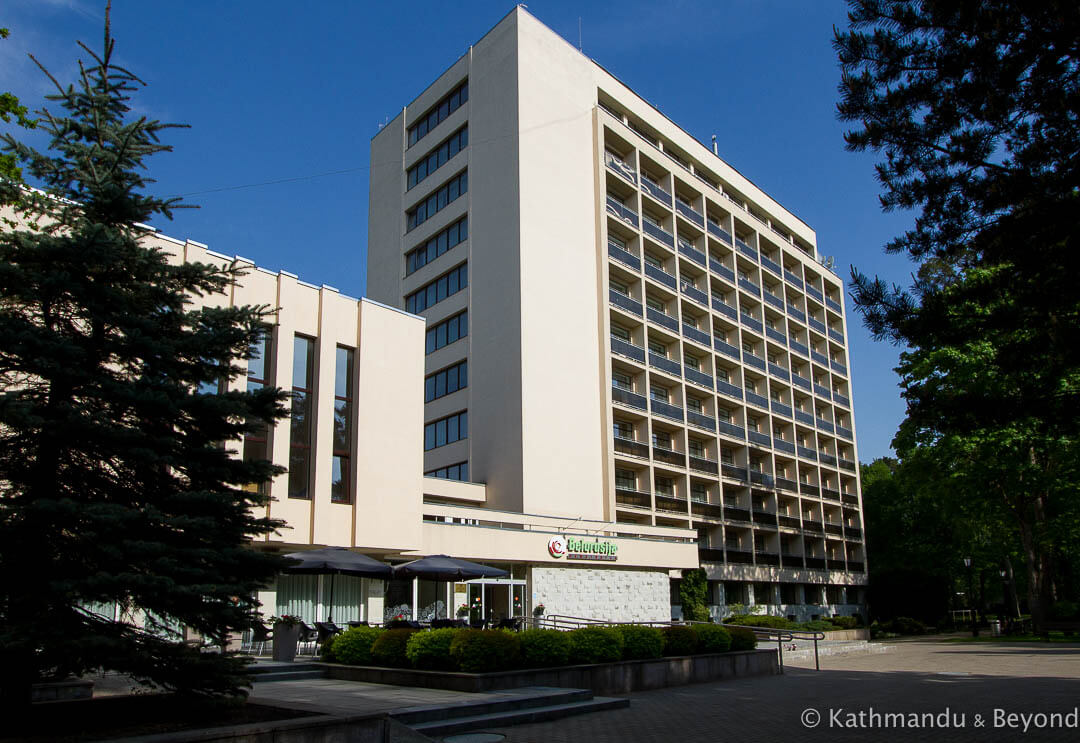 Belarusian Sanatorium
Belarusian Sanatorium
As the sanatorium was busy when we visited, no-one really noticed us and we were able to have a good wander around the building’s interior which was wonderfully retro and had probably the most stunning staircase and stained-glass backdrop combination that we have ever seen!
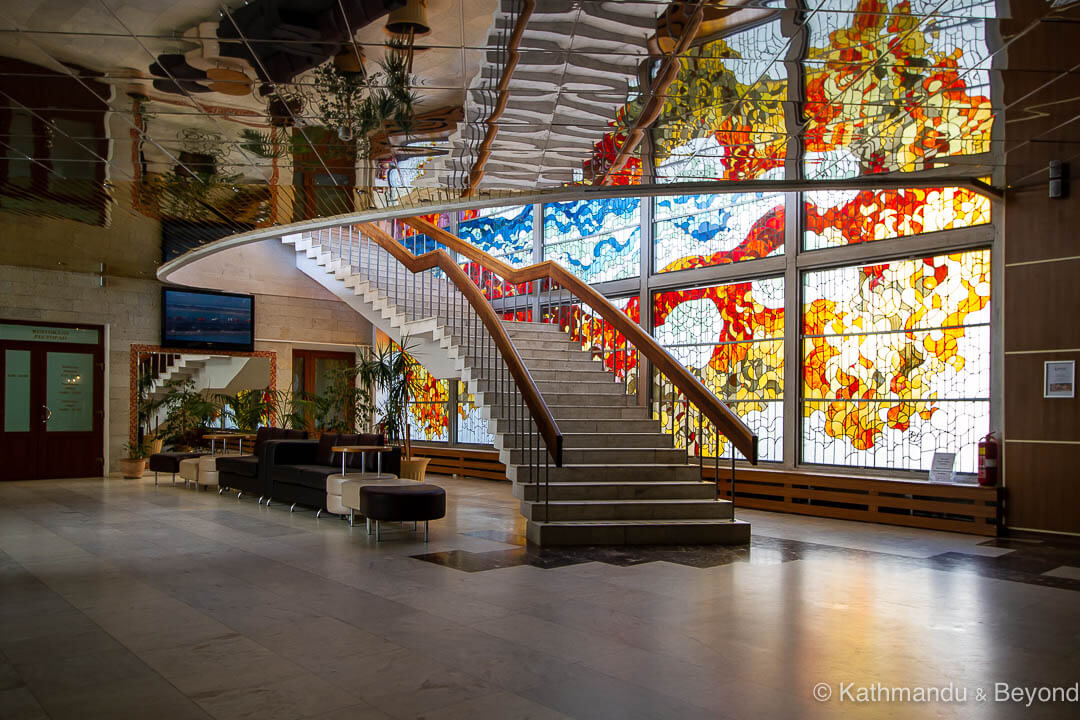 Interior of the Belarusian Sanatorium
Interior of the Belarusian Sanatorium
Baltic Beach Hotel and SPA
Protruding out over the beach like a sore thumb, this resort, looking very much like a beached cruise liner, was originally called Sanatorium Rigas. But, apart from the fact that it was completed in 1981, that’s about all I was able to find out about its past. Today it is one of the smartest health resorts in the area – all the bedrooms and public areas have been renovated and it’s only the property’s gargantuan shape that gives away the fact that this sanatorium’s roots are well and truly embedded in the former Soviet Union.
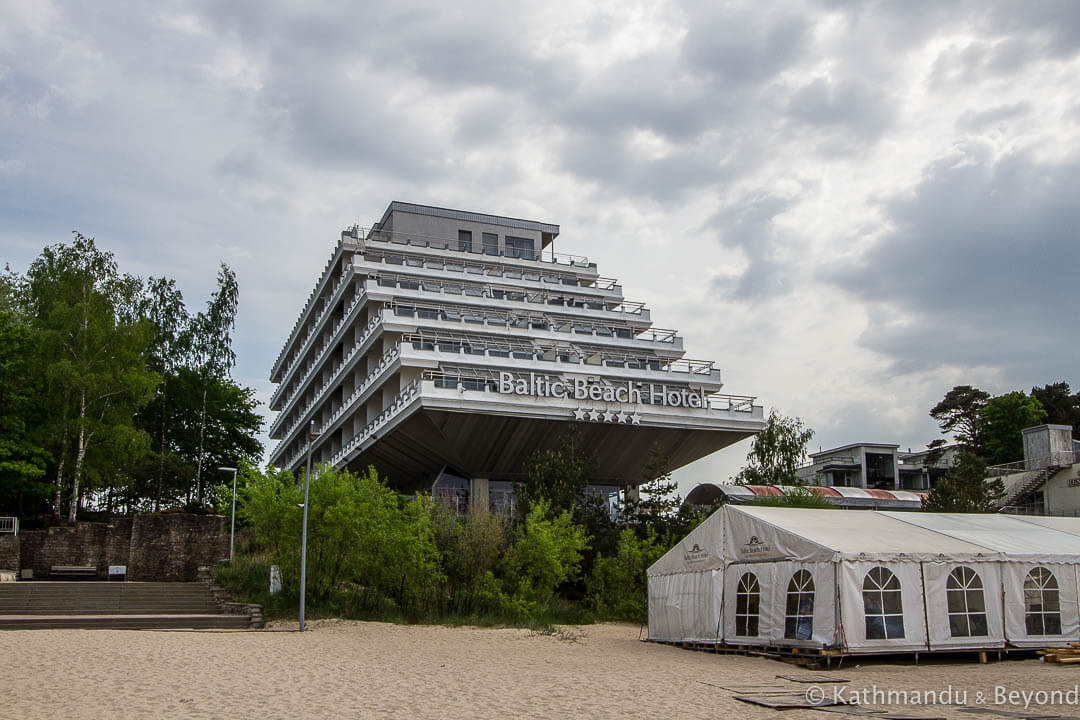 Baltic Beach Hotel and SPA
Baltic Beach Hotel and SPA
National Rehabilitation Centre Vaivari
This is another sanatorium with a futuristic design. In the case of the National Rehabilitation Centre Vaivari, it’s hardly surprising that the blueprint for the property was such, given the building was originally constructed as a place of relaxation and recovery for those who worked as part of the Soviet space program. It was built at some point in the 1970s and used to be called the All-Union Space Research Workers Sanatorium and also, simply, the Cosmonaut Sanatorium.
Of all the sanatoriums we visited in Jūrmala, this one felt the most like God’s waiting room. The reception area and corridors leading off it had that distinctive hospital smell and when we ventured close to the dining room, the smell of boiled cabbage was quite overwhelming. Still, the marvellous exterior, which was awash with battleship grey, more than made up for it.
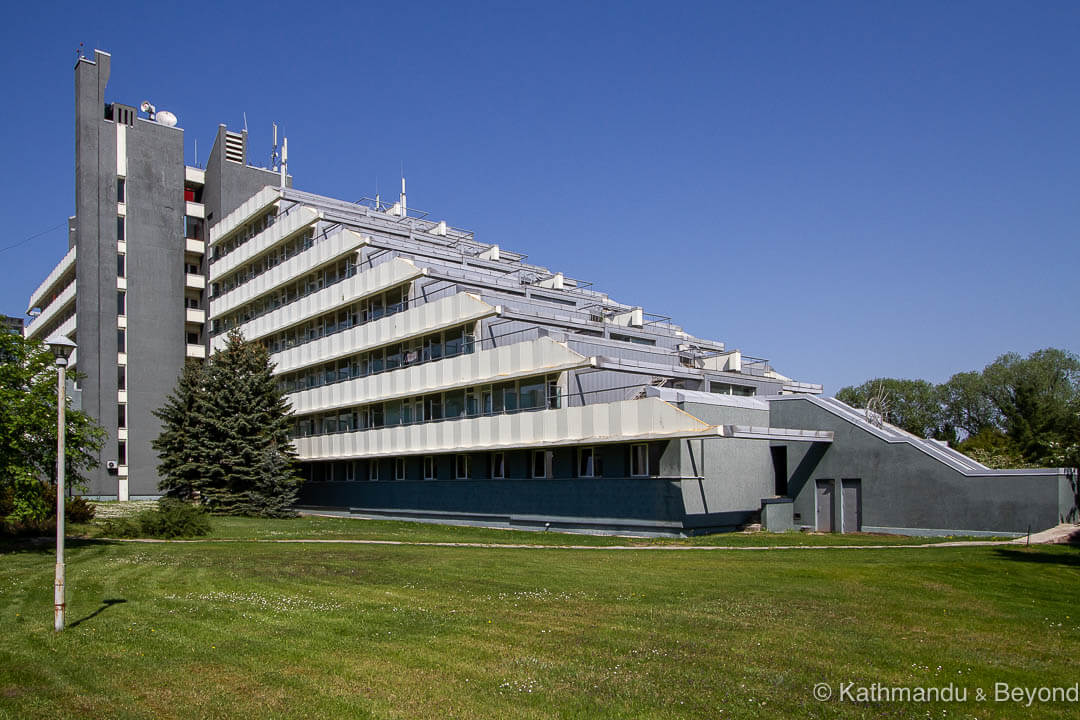 National Rehabilitation Centre Vaivari
National Rehabilitation Centre Vaivari
Jaunķemeri Rehabilitation Centre
The Jaunķemeri Rehabilitation Centre was established in 1967 as a centre for balneotherapy (the treatment of disease by bathing in mineral waters). Originally called the Sanatorium Jaunķemeri, this ultra-white, modernist-style building looked far more clinical than any of the other medical hotels we visited.
Quite a few of the remaining Soviet-era sanatoriums have diversified from their original purpose in recent times. Take the Baltic Beach Hotel and SPA mentioned above for example – I would imagine treatments are not as harsh as they once were (unless you ask for them that way, of course!) and if you want to sip a G&T by the pool come sundowner time I doubt if you would get berated for it today. But, I suspect the Jaunķemeri Rehabilitation Centre is old school when it comes to the way it operates and you would only check in to if you had something properly wrong with you.
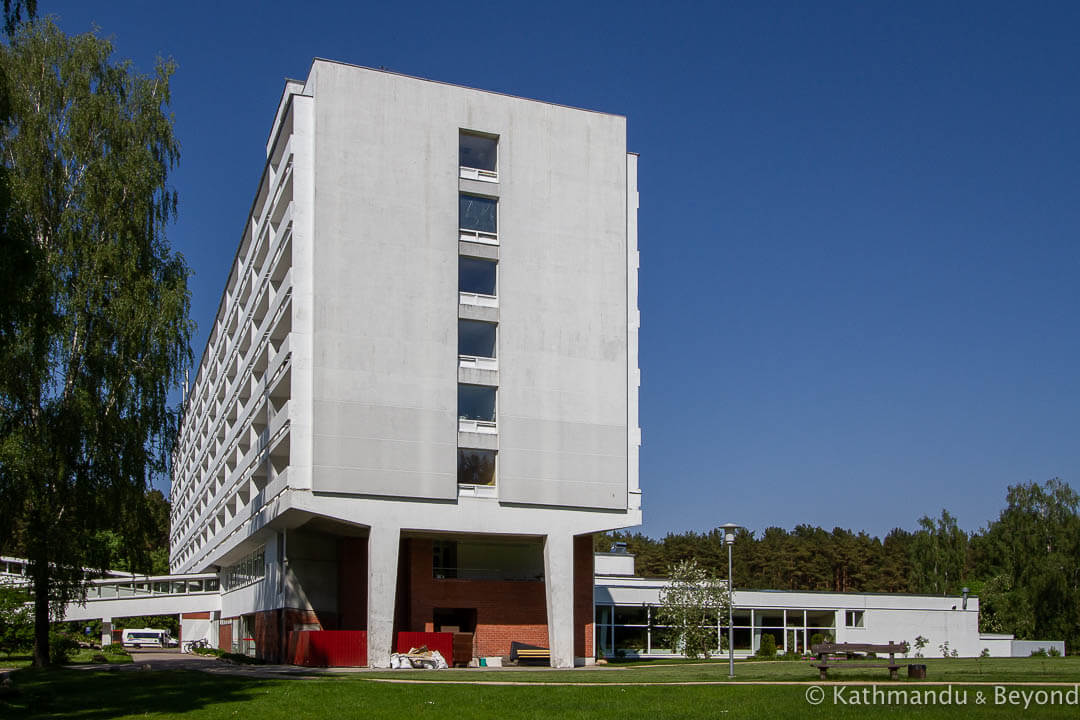 Jaunķemeri Rehabilitation Centre
Jaunķemeri Rehabilitation Centre
Spa Medical Resort Jantarnij Bereg
Complete with a classic 1970s entrance and Soviet-style reception, this is another property that remains stuck in a fascinating time warp.
Surrounded on all sides by dense forest, this sanatorium had the largest amount of outdoor space of any of the locations we visited. There was also an ornate indoor swimming pool at this sanatorium which would have been fantastic to have seen close up but, unfortunately for us, there was a class going on and so we only managed a quick glimpse before moving on.
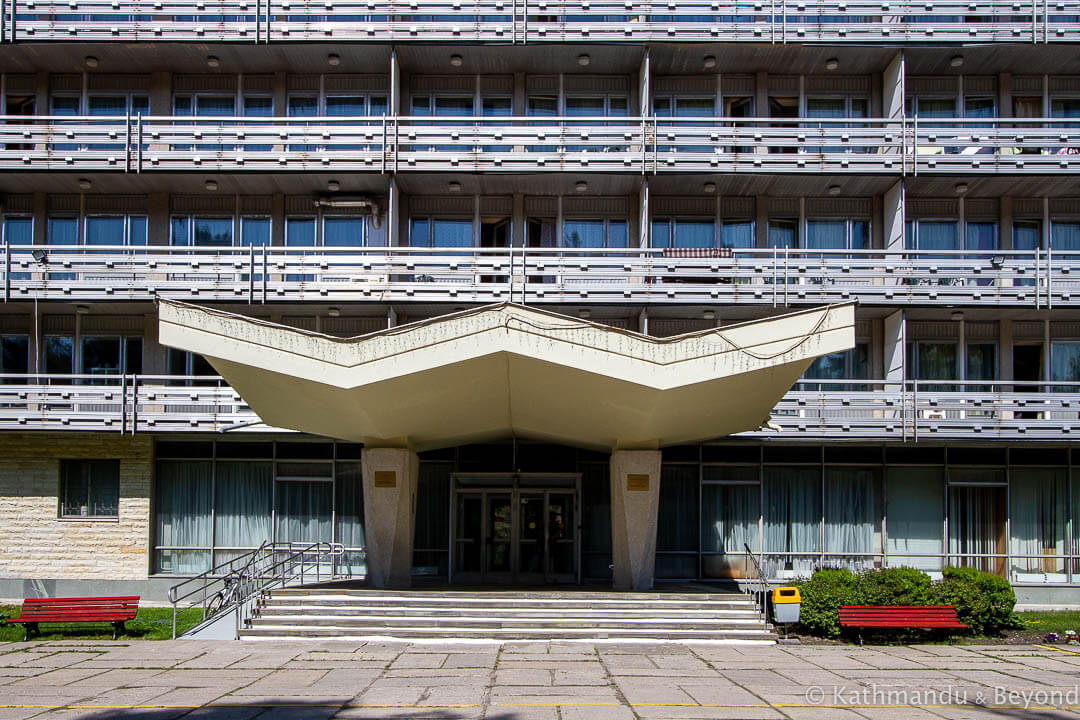 Spa Medical Resort Jantarnij Bereg
Spa Medical Resort Jantarnij Bereg
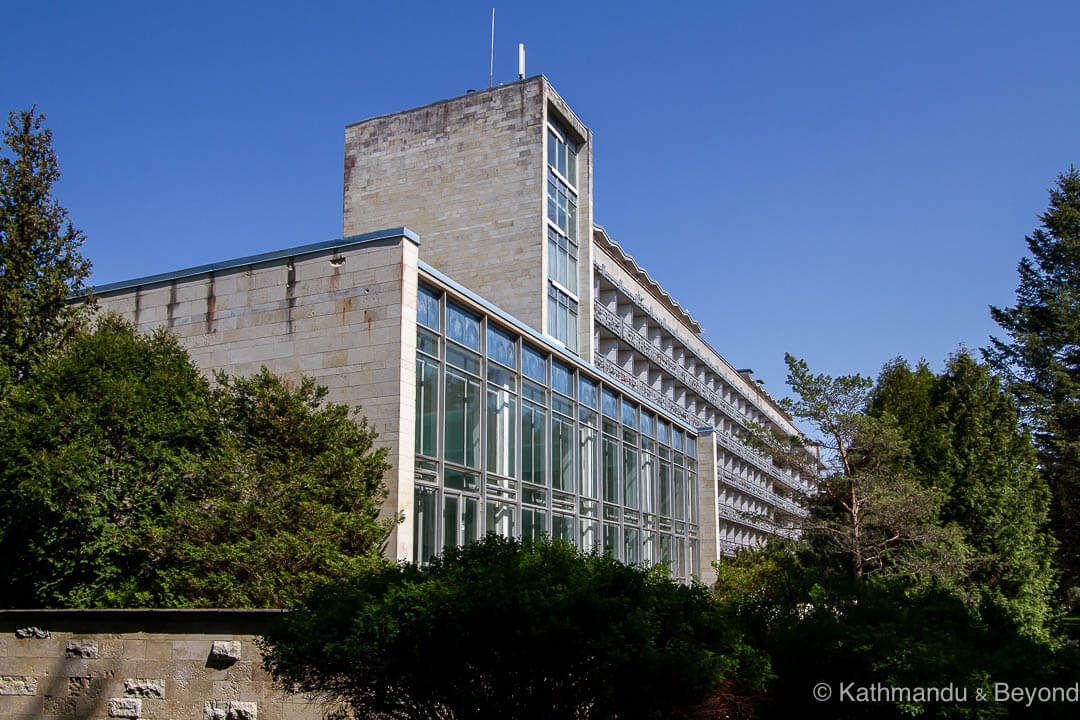
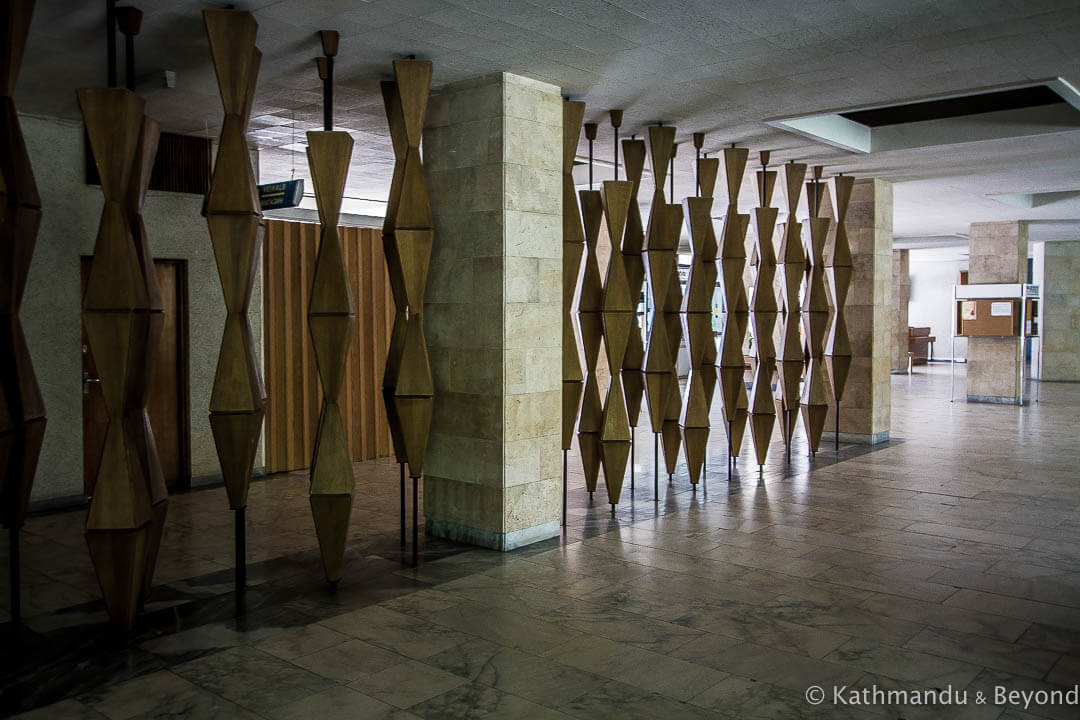
Spa Medical Resort Jantarnij Bereg
Although currently experiencing a bit of a revival, visitor numbers to Jūrmala are nowhere near those before the collapse of the Soviet Union. In a twist of fate, citizens from eight of the countries that used to form the USSR, including Russia, now need a visa to visit Latvia. Although the application isn’t overly stringent, there are still certain requirements to be adhered to (proof of funds and/or pre-booked accommodation, onward ticket, that sort of thing) and it’s probably enough to persuade these particular nationalities, who once made up the bulk of Jūrmala’s visitors, to go somewhere else instead.
Because of this, there is a rundown side to the city as well and we came across the odd abandoned sanatorium/hotel as well as quite a few of the more traditional wooden properties mentioned above that have also seen better days.
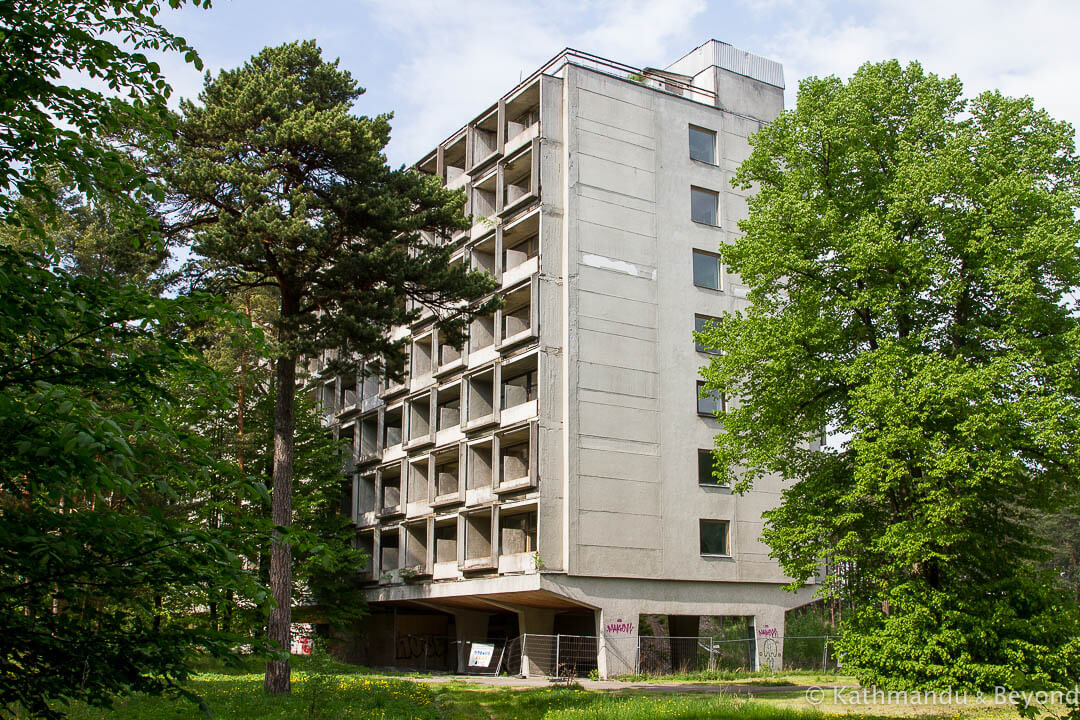 The abandoned Sanatorium Baltija (Baltic) in Jūrmala. When active, the institution specialised in treating liver and intestinal related diseases
The abandoned Sanatorium Baltija (Baltic) in Jūrmala. When active, the institution specialised in treating liver and intestinal related diseases
Visiting the Soviet-era Sanatoriums in Jūrmala
Getting to Jūrmala from Riga is very easy on the train. They leave at regular intervals from Riga Central Station and the journey time is about 30 minutes. A one-way ticket costs approximately €1.50 depending on which station you get off at in Jūrmala.
There are several railway stations in Jūrmala district. Vaivari Station is the closest station for National Rehabilitation Centre Vaivari, while Dubulti Station is the closest for the Baltic Beach Hotel and SPA. To get to the Belarusian Sanatorium, it’s best to take a train to Bulduri Station. Unfortunately, Jaunķemeri Rehabilitation Centre and Spa Medical Resort Jantarnij Bereg, both of which are close to each other, do not have a convenient railway station – the nearest, Sloka Station, is about 5km away.
A good option if you don’t have your own transport, would be to take the train from Riga to Bulduri Station and then walk to Dubulti Station via the abandoned sanatorium marked on the map and also the Baltic Beach Hotel and SPA. This is a nice walk and if you stay on the quiet main road behind the beach you will also see some of Jūrmala’s historic wooden buildings. At Dubulti Station you can board another train to Vaivari Station in order to see the National Rehabilitation Centre Vaivari. At this point, you can either call it a day or take another train to Sloka Station and then find a taxi to ferry you to and from Jaunķemeri Rehabilitation Centre and Spa Medical Resort Jantarnij Bereg before finally heading back to Riga.
This map will help visualise the suggestion above.
If you are driving, parking is available inside the grounds or close by at each of the sanatoriums mentioned. During the summer months (April 1 to September 30), you will need to purchase a Jūrmala territory entrance ticket in order to enter the city limits. The price is currently €2 per car and there two toll booths (marked on the map) at either end of the town. Everything is done by vehicle registration and there is a €50 penalty if you get caught without one.
And one final recommendation. Don’t miss out on seeing Dubulti Station if you visit Jūrmala. Constructed in 1977, it is also known as Art Station Dubulti because it is now used as a contemporary art space as well as being a functioning station. Designed to conjure up images of waves in the sea, it is a glorious example of modernist architecture.
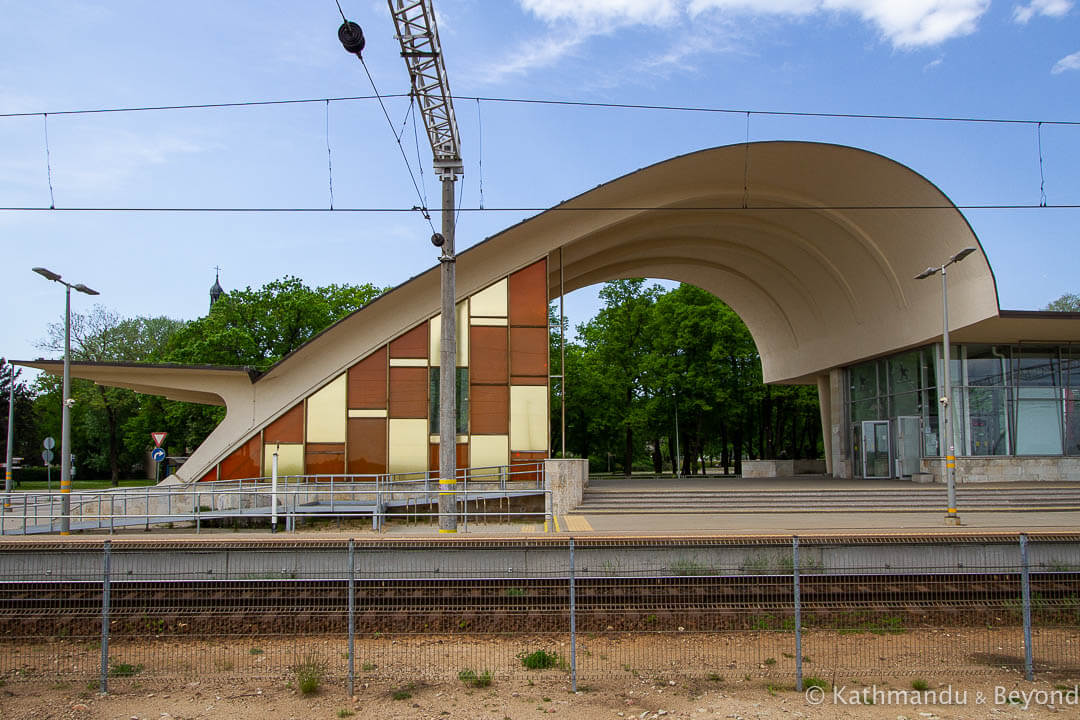 Dubulti Station in Jūrmala
Dubulti Station in Jūrmala
READ MORE BLOG POSTS ABOUT THE BALTIC STATES





I think you may have missed two which are in Ruined State and one that is not open yet.
Ruin 1
https://goo.gl/maps/x39XUcx7vNAGFD9K8
Ruin 2 – Currently mid demolition/renovation (as of January 2020)
https://goo.gl/maps/2ggqVWtFYoZv14Bj7
Unopened but Renovated
https://goo.gl/maps/GmZUVDw313vJGgVA9
As for “An abandoned sanatorium in Jūrmala” – Sanatorija Liva
Upon my last visit it appears to have been demolished as is currently Just rubble.
https://goo.gl/maps/MYAUWWMPsKaRcjRG9
Thanks very much for taking the time to send me these. Ruin 1 looks especially interesting. In fact, I have seen photos of that one since our visit. It appears to be pretty close to the Jantarnij Bereg – it’s a shame we missed it. I’ve just checked what I list as “An abandoned sanatorium in Jūrmala” and it is a different location from the one you sent on Google Maps so I don’t think it is the same one. The GPS for my “An abandoned sanatorium in Jūrmala” are 56.978583, 23.816500
We don’t currently have any plans to return to Jūrmala, or indeed Latvia, but when we do we will go hunting for some more of these! Thanks again.